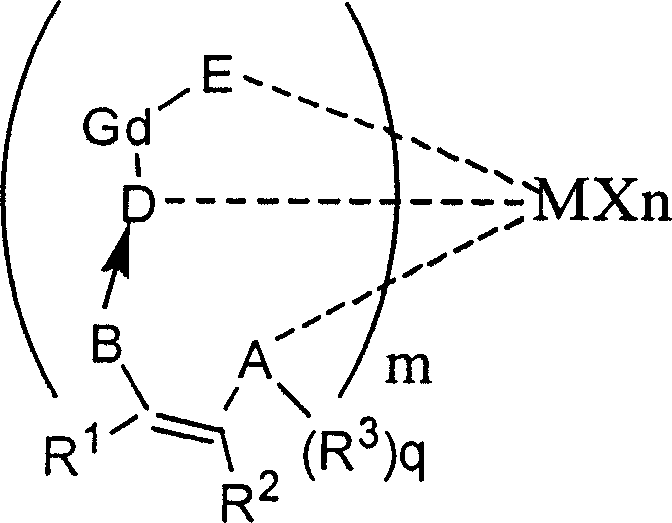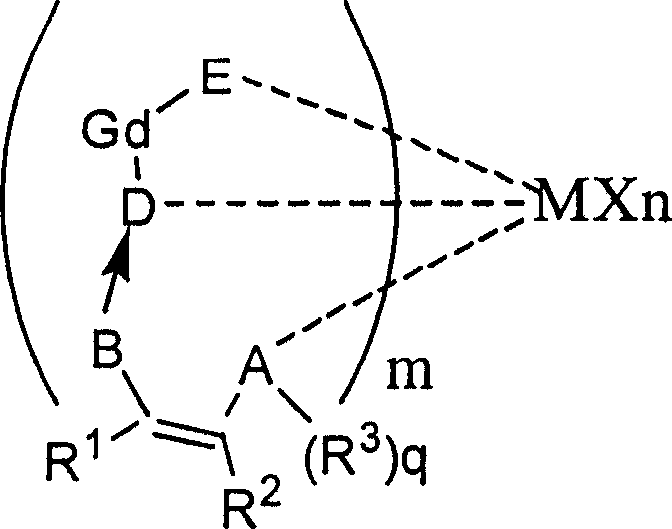Loaded method of load type Non-metallocene catalyst-and polymerizing application
A non-metallocene and catalyst technology, applied in the field of catalyst support and organic polymerization, can solve the problems of needing microwave devices and not easy to operate, and achieve the effect of high melting point
- Summary
- Abstract
- Description
- Claims
- Application Information
AI Technical Summary
Problems solved by technology
Method used
Image
Examples
Embodiment 1
[0121] 1.1 Preparation of supported catalyst
[0122] 1.1.1 Activation of the carrier
[0123] Take ES-70 type silica gel (product of Crosfield Company) and fire under nitrogen atmosphere. The calcination conditions are: heating rate 5℃ / Min, constant temperature at 200℃ for 0.5h, constant temperature at 400℃ for 0.5h, then constant temperature at 600℃ for 4h, and finally natural cooling under nitrogen atmosphere. Marked as ES-70-600 carrier.
[0124] 1.1.2 Chemical treatment of the carrier
[0125] In an anhydrous and oxygen-free nitrogen atmosphere (both water and oxygen content are less than 5 ppm), 2.0413g of ES-70-600 carrier is taken, 20ml of toluene solvent is added and stirred to form a suspension. Take 2ml of methylaluminoxane (MAO) in toluene solution (abbreviated as original MAO, MAO accounts for 15% by weight, product of Witco), and slowly drop it into the above suspension at 25°C under stirring conditions. Continue to stir for 2h. Then take titanium tetrachloride (TiCl...
Embodiment 2
[0135] 2.1 Preparation of catalyst
[0136] The preparation process of the catalyst is similar to that in Example 1.1. Take 2.048 g of ES-70-600 carrier and add 20 ml of toluene solvent. Slowly add 2ml of MAO toluene solution (dilute the original MAO and toluene 1:9, abbreviated as dilute MAO), and then slowly add 10ml of TiCl. 4 Hexane solution (titanium content 0.41mol / L), then washed, filtered, dried and drained.
[0137] Weigh 224 mg of the non-metallocene olefin polymerization catalyst and dissolve it in 40 ml of toluene solvent, then add it to the carrier powder and stir for 12 hours. Finally, it is washed, filtered, dried and drained.
[0138] The titanium content of the supported non-metallocene olefin polymerization catalyst is 2.4%.
[0139] 2.2 Aggregation
[0140] In a 0.5L autoclave, 48.7mg of supported catalyst, 4ml of original MAO and 250ml of hexane solvent were added at the same time, and ethylene polymerization was carried out at an ethylene pressure of 1.04MPa. ...
Embodiment 3
[0151] The preparation of the catalyst is similar to that of Example 1.1. Take 2.008 g of ES-70-600 carrier and add 20 ml of toluene solvent. Slowly add 10ml TiCl dropwise 4 Hexane solution (titanium content 0.41mol / L), then washed, filtered, dried and drained. Weigh 191.4 mg of non-metallocene olefin polymerization catalyst and dissolve it in 35 ml of toluene, add it to the carrier powder, and stir for 12 hours. Finally, it is washed, filtered, dried and drained.
[0152] The titanium content of the supported non-metallocene olefin polymerization catalyst is 2.57%.
[0153] The polymerization process is similar to that in Example 1.2. In a 0.5L autoclave, 54.1mg of supported catalyst, 4ml of original MAO and 250ml of hexane solvent were added simultaneously, and ethylene polymerization was carried out at an ethylene pressure of 1.04MPa, a stirring speed of 560rpm and a constant temperature of 50°C. The reaction time is 2h.
[0154] Yield: 13.45g, the melting point of polyethylene...
PUM
| Property | Measurement | Unit |
|---|---|---|
| Melting point | aaaaa | aaaaa |
| Melting point | aaaaa | aaaaa |
| Melting point | aaaaa | aaaaa |
Abstract
Description
Claims
Application Information
 Login to View More
Login to View More - R&D
- Intellectual Property
- Life Sciences
- Materials
- Tech Scout
- Unparalleled Data Quality
- Higher Quality Content
- 60% Fewer Hallucinations
Browse by: Latest US Patents, China's latest patents, Technical Efficacy Thesaurus, Application Domain, Technology Topic, Popular Technical Reports.
© 2025 PatSnap. All rights reserved.Legal|Privacy policy|Modern Slavery Act Transparency Statement|Sitemap|About US| Contact US: help@patsnap.com



